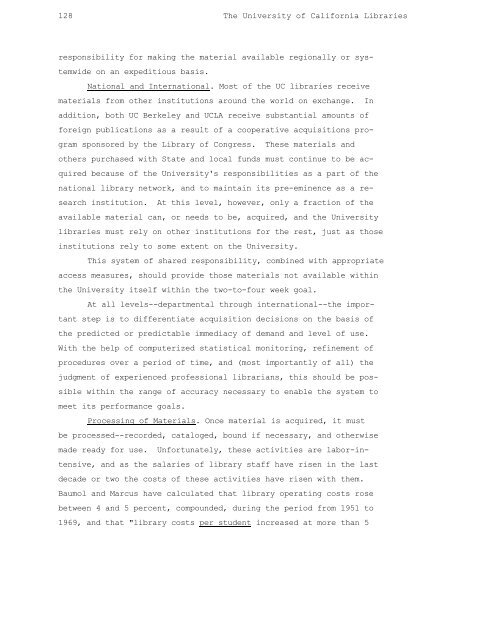The University of California Libraries: A Plan for Development (1977)
The University of California Libraries: A Plan for Development (1977)
The University of California Libraries: A Plan for Development (1977)
Create successful ePaper yourself
Turn your PDF publications into a flip-book with our unique Google optimized e-Paper software.
128 <strong>The</strong> <strong>University</strong> <strong>of</strong> <strong>Cali<strong>for</strong>nia</strong> <strong>Libraries</strong><br />
responsibility <strong>for</strong> making the material available regionally or systemwide<br />
on an expeditious basis.<br />
National and International. Most <strong>of</strong> the UC libraries receive<br />
materials from other institutions around the world on exchange. In<br />
addition, both UC Berkeley and UCLA receive substantial amounts <strong>of</strong><br />
<strong>for</strong>eign publications as a result <strong>of</strong> a cooperative acquisitions program<br />
sponsored by the Library <strong>of</strong> Congress. <strong>The</strong>se materials and<br />
others purchased with State and local funds must continue to be acquired<br />
because <strong>of</strong> the <strong>University</strong>'s responsibilities as a part <strong>of</strong> the<br />
national library network, and to maintain its pre-eminence as a research<br />
institution. At this level, however, only a fraction <strong>of</strong> the<br />
available material can, or needs to be, acquired, and the <strong>University</strong><br />
libraries must rely on other institutions <strong>for</strong> the rest, just as those<br />
institutions rely to some extent on the <strong>University</strong>.<br />
This system <strong>of</strong> shared responsibility, combined with appropriate<br />
access measures, should provide those materials not available within<br />
the <strong>University</strong> itself within the two-to-four week goal.<br />
At all levels--departmental through international--the important<br />
step is to differentiate acquisition decisions on the basis <strong>of</strong><br />
the predicted or predictable immediacy <strong>of</strong> demand and level <strong>of</strong> use.<br />
With the help <strong>of</strong> computerized statistical monitoring, refinement <strong>of</strong><br />
procedures over a period <strong>of</strong> time, and (most importantly <strong>of</strong> all) the<br />
judgment <strong>of</strong> experienced pr<strong>of</strong>essional librarians, this should be possible<br />
within the range <strong>of</strong> accuracy necessary to enable the system to<br />
meet its per<strong>for</strong>mance goals.<br />
Processing <strong>of</strong> Materials. Once material is acquired, it must<br />
be processed--recorded, cataloged, bound if necessary, and otherwise<br />
made ready <strong>for</strong> use. Un<strong>for</strong>tunately, these activities are labor-intensive,<br />
and as the salaries <strong>of</strong> library staff have risen in the last<br />
decade or two the costs <strong>of</strong> these activities have risen with them.<br />
Baumol and Marcus have calculated that library operating costs rose<br />
between 4 and 5 percent, compounded, during the period from 1951 to<br />
1969, and that "library costs per student increased at more than 5
















